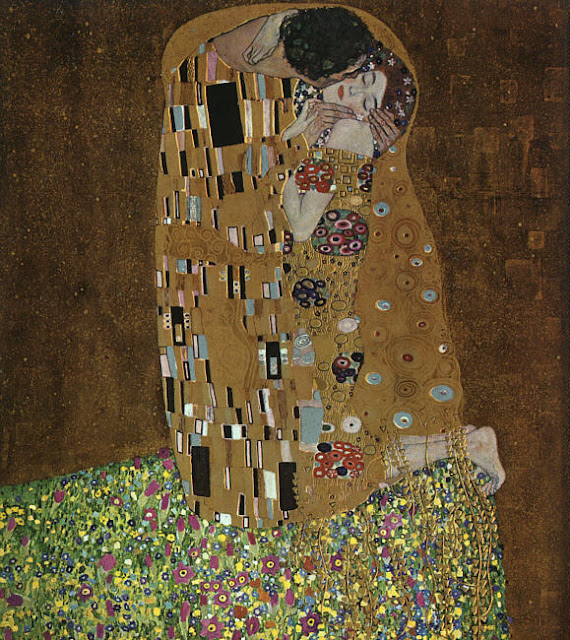Gustav Klimt
Gustav Klimt (14 luglio 1862 - 6 febbraio 1918) è stato un pittore simbolista austriaco e uno dei membri più importanti del movimento della Secessione viennese. Klimt è noto per i suoi dipinti, murales, schizzi e altri oggetti d'arte. Il soggetto principale di Klimt era il corpo femminile e le sue opere sono caratterizzate da un chiaro erotismo. Oltre alle sue opere figurative, che includono allegorie e ritratti, ha dipinto paesaggi. Tra gli artisti della Secessione viennese, Klimt è stato il più influenzato dall'arte giapponese e dalle sue tecniche.
All'inizio della sua carriera artistica, è stato un pittore di successo di decorazioni architettoniche con uno stile convenzionale. Quando iniziò a sviluppare uno stile più personale, il suo lavoro fu oggetto di controversie che culminarono quando i dipinti che completò intorno al 1900 per il soffitto della Sala Grande dell'Università di Vienna furono criticati come pornografici. Successivamente non accetta più commissioni pubbliche, ma ottiene un nuovo successo con i dipinti della sua "fase d'oro", molti dei quali includono la foglia d'oro. Il lavoro di Klimt ha avuto un'influenza importante sul suo giovane collega Egon Schiele.
Klimt aveva trasformato l'allegoria e il simbolismo tradizionali in un nuovo linguaggio che era più apertamente sessuale e quindi più inquietante per alcuni. La protesta pubblica proveniva da tutti i settori: politico, estetico e religioso. Di conseguenza, i dipinti (visti nella galleria sotto) non sono stati visualizzati sul soffitto della Sala Grande. Questa sarebbe l'ultima commissione pubblica accettata dall'artista.
Gustav Klimt (July 14, 1862 – February 6, 1918) was an Austrian symbolist painter and one of the most prominent members of the Vienna Secession movement. Klimt is noted for his paintings, murals, sketches, and other objet d'art. Klimt's primary subject was the female body, and his works are marked by a frank eroticism. In addition to his figurative works, which include allegories and portraits, he painted landscapes. Among the artists of the Vienna Secession, Klimt was the most influenced by Japanese art and its methods.
Early in his artistic career, he was a successful painter of architectural decorations in a conventional manner. As he began to develop a more personal style, his work was the subject of controversy that culminated when the paintings he completed around 1900 for the ceiling of the Great Hall of the University of Vienna were criticized as pornographic. He subsequently accepted no more public commissions, but achieved a new success with the paintings of his "golden phase", many of which include gold leaf. Klimt's work was an important influence on his younger peer Egon Schiele.
Klimt had transformed traditional allegory and symbolism into a new language that was more overtly sexual and hence more disturbing to some. The public outcry came from all quarters—political, aesthetic and religious. As a result, the paintings (seen in gallery below) were not displayed on the ceiling of the Great Hall. This would be the last public commission accepted by the artist.
The Kiss, 1907-08, Österreichische Galerie Belvedere (Vienna)
Roses Under the Trees, 1905, Musée d'Orsay (Paris)
Josef Lewinsky, 1895, Österreichische Galerie Belvedere (Vienna)
Sonja Knips, 1898, Österreichische Galerie Belvedere (Vienna)
Serena Lederer, 1899, Collection of Erich Lederer (Geneva)
The Black Feather Hat, 1910, Private Collection (Graz)
Elisabeth Bachofen-Echt, 1914, private collection (Basilea)
Love, 1895, Historisches Museum der Stadt Wien (Vienna)
Moving Water, 1898, private collection (New York)
Water Serpents, 1904-1907, Österreichische Galerie Belvedere (Vienna)
Farm Garden with Sunflowers, 1905-06, Österreichische Galerie Belvedere (Vienna)
Drawing for "Two Emblems for Ver Sacrum" (Nuda Veritas), 1898, Galerie Welz (Salzburg)
Drawing for "Two Emblems for Ver Sacrum" (Der Neid), 1898, Galerie Welz (Salzburg)
Joseph Pembauer, 1890, Tiroler Landesmuseum Ferdinandeum (Innsbruck)
Margaret Stonborough-Wittgenstein, 1905, Neue Pinakothek (Munich)
Mäda Primavesi, 1912, private collection (New York)
Baby, 1917-18, private collection (New York)
Music I, 1895, Neue Pinakothek (Munich)
Expectation, 1905-09, Österreichisches Museum für Angewandte Kunst (Vienna)
Fulfillment, 1905-09, Österreichisches Museum für Angewandte Kunst (Vienna)
Emilie Flöge, 1902, Historisches Museum der Stadt Wien (Vienna)
Adele Bloch-Bauer I, 1907, Österreichische Galerie Belvedere (Vienna)
Medicine (compositional study), 1897-98, private collection (Vienna)
Pallas Athene, 1898, Historisches Museum der Stadt Wien (Vienna)
Judith I, 1901, Österreichische Galerie Belvedere (Vienna)
Hope I, 1903, The National Gallery (Ottawa)
Danae, 1907-08, private collection (Graz)
Judith II, 1909, Galleria d'Arte Moderna (Venice)
Adam and Eve, 1917-18, Österreichische Galerie Belvedere (Vienna)
Beech Forest I, 1902, Moderne Galerie (Dresden)
Pear Tree, 1903, Busch-Reisinger Museum at Harvard University
The Sunflower, 1906-07, private collection
Avenue in Schloss Kammer Park, 1912, Österreichische Galerie Belvedere (Vienna)



































Comments